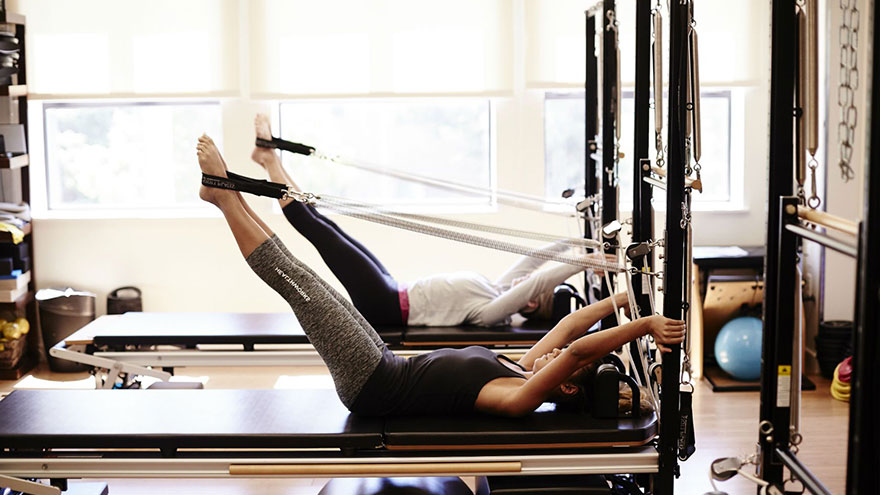How to Use the Reformer to Open & Strengthen Hips
Dancers inspire hip envy, but developing those chiseled muscles takes work. If you’re a dancer, or if you wish to look just like one, the Pilates reformer enables this detailed sculpting process. Its springs, straps and gliding carriage support gluteus medius exercise, which opens, or externally rotates your hips; hip abductor or outer thigh exercises, which move your leg away from your center; and gluteus maximus exercise, which extends your hip, moving your leg behind your body. The reformer’s coordinated muscle action enhances hip strength and mobility. Three weekly workouts, and you’ll look and feel great. You might even dance.
Things You’ll Need
- Pilates reformer
- Jump board (optional)
- Pilates reformer box
5 Steps to Use the Reformer to Open & Strengthen Hips

1. Adjust the reformer for your warm-up by securing one or two springs, located at the bottom of the carriage, to the attachments near the foot bar.
Lie supine on the carriage with your toes on the footbar, heels together, feet turned out and knees bent. Inhale, straighten your legs and zip your inner thighs together. Exhale, bend your knees and return to the starting position. Perform 20 reps at a moderate pace to raise your body temperature and warm up your hips. Add challenge over time by attaching the jump board to the foot bar, and use a plyometric jumping action to extend your legs.
2. Add one or two more springs to the carriage, and remain supine for the “frog” position.
Reach behind you for the straps and place your feet in the stirrups. Bend your knees, place your heels together and turn feet away from each other, externally rotating your hips into the “frog” position used in the footwork. Inhale to prepare. Exhale, contract your inner thighs and lower your legs to a 45-degree angle. Engage your core and press your back into the mat. This exercise takes the footwork to a new level, because your back is in an unsupported position. Progress by lifting your hips from the mat when your knees are bent, and rolling your spine into the carriage as you straighten and lower your legs.
3. Keep your feet in the stirrups and straighten your legs to a 90-degree angle to address the hip abductors and adductors.
Turn your legs out, inhale, and press your legs apart. Exhale, circle your legs around until your adductors draw them together, and return to the starting position. Do five to 10 reps. Since your legs remain straight, this poses additional challenges on your core muscles. Only add more springs if you can maintain a flat back. Stay with lighter springs if you want to increase your range of motion while strengthening your hips.
4. Position the box on the reformer, in front of the shoulder pads.
Lie on one side on top of the box, with your bottom leg bent, your top leg straight and your head resting in the palm of your hand. Attach the reformer strap to your top foot. Inhale and swing your leg forward. Exhale and swing it back behind you. Do 10 reps on each side. As the leg swings back behind you, the hip extension movement engages your gluteus maximus. Apply the core control you learned in the supine exercises, and maintain a stable pelvis as your leg move forward and back. Do 10 reps using two to four springs.
5. Lower the foot-bar on the reformer to perform standing hip openers, which provide a more functional version of the supine and side-lying exercises.
Step onto the stable platform with one foot and place your other foot on the carriage. Stand in an upright position. Turn your legs out, so that your heels face each other and your feet turn out. Inhale, contract your hip abductors and press your leg out to the side, moving the carriage away from the springs. Exhale and return to center. Do 10 reps on each leg. Two to three springs will give you a wider range of motion. Four springs gives you more resistance.
- If your hips feel particularly tight, warm up by lying supine on the carriage, bending your knee to your chest, and performing five clockwise and counterclockwise circles on each leg.
- If you have trouble stabilizing your back during the frog exercise, take off the straps and place your feet on the foot bar. Start in the same, bent-knee and externally rotated position, and perform the same movements with your feet on the bar.
- Engage you core muscles and perform all movements with control.
- Concentrate on quality of movement rather than quantity of reps.
- Stabilize the carriage before getting on.
- The spring and foot-bar design differs slightly according to the reformer manufacturer. Ask an instructor to assist you in lowering the foot-bar, adjusting the springs, and determining how many springs you need for each exercise.
You Might Also Like :: Does Cycling Burn Weight Faster Than Running?

